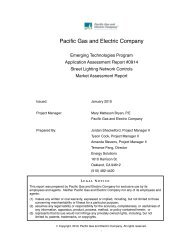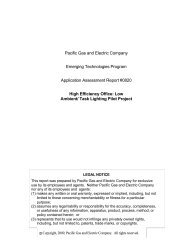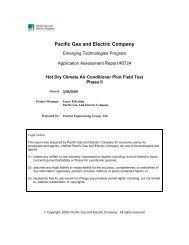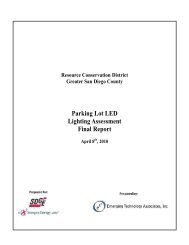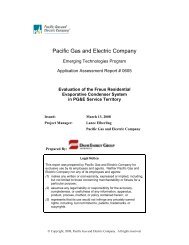Laboratory Evaluation of the OASys Indirect/Direct Evaporative
Laboratory Evaluation of the OASys Indirect/Direct Evaporative
Laboratory Evaluation of the OASys Indirect/Direct Evaporative
You also want an ePaper? Increase the reach of your titles
YUMPU automatically turns print PDFs into web optimized ePapers that Google loves.
These numbers are close to those selected for <strong>the</strong> CEC Title-20 ECER rating (91°Fdb / 69°Fwb), except for<br />
<strong>the</strong> inlet dry-bulb temperature.<br />
The <strong>OASys</strong> was subjected to most <strong>of</strong> <strong>the</strong> same conditions that were developed for <strong>the</strong> previous<br />
evaporative cooler tests. These conditions were selected based on <strong>the</strong> desire to evaluate <strong>the</strong> performance<br />
<strong>of</strong> <strong>the</strong> test units over a range <strong>of</strong> environmental conditions that would adequately represent <strong>the</strong> climate<br />
during <strong>the</strong> cooling season at various locations in PG&E’s service territory. The ASHRAE Handbook <strong>of</strong><br />
Fundamentals (Reference 1) gives tables <strong>of</strong> cooling design condition for a large number <strong>of</strong> cities,<br />
including 19 within <strong>the</strong> PG&E service territory. The tables list a number <strong>of</strong> useful climate design<br />
conditions, and <strong>of</strong> particular interest are <strong>the</strong> listings for conditions that are exceeded less than 0.4% <strong>of</strong> a<br />
year (about 35 hours) on average. These design conditions include:<br />
• Maximum dry-bulb temperature and coincident wet-bulb temperature (used in determining <strong>the</strong><br />
cooling load on a building).<br />
• Maximum wet-bulb temperature and coincident dry-bulb temperature (used for sizing cooling towers<br />
and o<strong>the</strong>r evaporative equipment)<br />
An excerpt from this table showing <strong>the</strong> cities in <strong>the</strong> PG&E service territory is shown in Table 2:<br />
Table 2: ASHRAE Design Conditions for Cities in PG&E Service Territory<br />
Climate Std P Cooling DB/CWB Evaporation WB/CDB<br />
City Zone Elev. PSIA DB MWB WBD RH WB MDB WBD RH<br />
Alameda NAS 3 13 14.688 83 65 18 38% 67 79 12 54%<br />
Arcata / Eureka 1 217 14.581 70 60 10 56% 62 67 5 76%<br />
Bakersfield 13 492 14.436 104 70 34 18% 73 98 25 31%<br />
Blue Canyon 16 5,285 12.097 84 59 25 24% 62 80 18 39%<br />
Fairfield (Travis AFB) 12 62 14.662 98 67 31 18% 70 92 22 33%<br />
Fresno 13 328 14.522 103 71 32 20% 73 98 25 30%<br />
Lemoore (Reeves NAS) 13 236 14.570 103 72 31 22% 75 97 22 36%<br />
Marysville (Beale AFB) 11 112 14.636 101 70 31 21% 72 97 25 30%<br />
Merced (Castle AFB) 12 187 14.596 99 69 30 21% 72 96 24 31%<br />
Mount Shasta 16 3,543 12.909 91 62 29 20% 64 87 23 30%<br />
Mountain View (M<strong>of</strong>fat NAS) 4 39 14.675 88 65 23 28% 68 82 14 49%<br />
Paso Robles 4 837 14.257 102 68 34 16% 70 97 27 26%<br />
Red Bluff 11 354 14.508 105 70 35 16% 72 98 26 28%<br />
Sacramento (NE - McClellan AFB) 12 75 14.655 102 70 32 19% 72 97 25 30%<br />
Sacramento (NW - Metro AP) 12 23 14.683 100 69 31 20% 72 96 24 31%<br />
Sacramento (SE - Ma<strong>the</strong>r Field) 12 95 14.645 101 69 32 19% 71 97 26 28%<br />
Salinas 3 85 14.650 83 63 20 32% 66 78 12 53%<br />
San Francisco 3 16 14.687 83 63 20 32% 64 79 15 44%<br />
San Jose (Int'l AP) 4 56 14.666 93 67 26 25% 70 88 18 41%<br />
Santa Maria 5 240 14.569 86 63 23 27% 66 81 15 45%<br />
Stockton 12 26 14.681 100 69 31 20% 71 96 25 29%<br />
The numbers from this table were <strong>the</strong>n plotted on a psychrometric chart (Figure 8) in order to determine a<br />
matrix <strong>of</strong> test points that would <strong>the</strong>n capture <strong>the</strong> majority <strong>of</strong> those design conditions where <strong>the</strong> need for<br />
cooling is greatest. The selection <strong>of</strong> <strong>the</strong> test points needed to balance having enough to adequately<br />
represent <strong>the</strong> probable operating conditions, yet not be so great as to extend <strong>the</strong> testing period. Table 3<br />
lists <strong>the</strong> selected matrix <strong>of</strong> eight test conditions:<br />
491-06.12.doc 10




